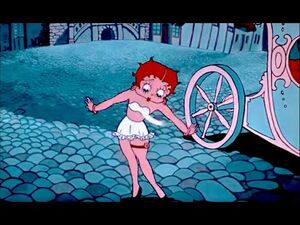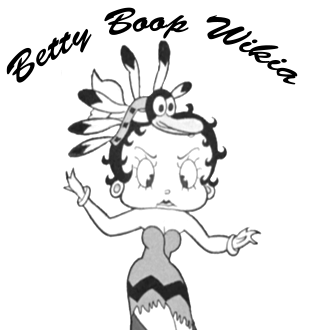Poor Cinderella
| Betty Boop in Poor Cinderella |
|---|
| Poor Cinderella | |
|---|---|
 | |
|
Name |
Poor Cinderella |
 | |
|
Name |
Poor Cinderella (1934) |
 | |
|
Name |
Poor Cinderella |
Poor Cinderella is a 1934 Fleischer Studios animated short film featuring Betty Boop. The first entry in the Color Classics series, Poor Cinderella was Fleischer Studios' first color film, and Betty's only appearance in color during the Fleischer era.
Betty Boop portrays Cinderella in a retelling of the classic tale of the same name. Betty lives with her wicked stepsisters, who treat her miserbly. When they refuse to allow her to attend the prince's ball, Betty cries until her fairy godmother tells her to get a pumpkin, mice and two lizards, and with a wave of her magic wand these items turn into a coach, a footman and horses.
Betty's rags turn into a resplendent white evening gown, complete with glass slippers. The fairy godmother warns Betty to be home by midnight or the magic will end and she will be in rags once more.
At the ball, Betty's appearance enchants everyone, especially the prince; he is smitten with this lovely young woman. They both dance until the clock strikes twelve, then, as Betty runs from the palace, in her haste she leaves behind one of her slippers.
The prince searches his kingdom for the woman who the slipper fits. All the girls in the realm try on the glass slipper, to no avail. Betty is given a chance, and it fits. She becomes the prince's bride, much to the displeasure of the two stepsisters. The two continue to argue at the gates of the prince's palace as the final credits roll.
Quotes
- Betty Boop: "I'm just a Poor Cinderella, but I'll be a princess someday!"
Characters
- Betty Boop as Cinderella
- Rudy Vallee
- Prince Charming
- Ugly Stepsisters/Wicked Stepsisters/Ugly Sisters/Evil Stepsisters
- Cupid
- Fairy Godmother
Cast & Crew
- Bonnie Poe as Betty Boop and Fairy Godmother
- Mae Questel (A small segment as Betty Boop)
- Rudy Vallee as himself
- Max Fleischer (Producer)
- Dave Fleischer (Director)
- Seymour Kneitel (Animator)
- Roland Crandall (Animator)
- William Henning (Animator)
- Murray Mencher (Music)
- Charles Tobias (Music)
- Jack Scholl (Music)
- Phil Spitalny (Recording)
Music
Gallery
Trivia
- Was released on the 3rd of August in 1934.
- Bonnie Poe was given the role of Betty in this film feature because she was a torch singer. The Fleischers had selected Poe, because she was skilled at sentimental love songs, torch songs, she was perfect for the role. Poe's little sister Evelyn Poe was also a torch singer, and around this time both sisters were working together as hostesses at night clubs.
- There is a small voice-over sequence where Mae Questel takes over, while Betty is collecting a pumpkin next to the mice, Questel's small line in the cartoon is; "Here they are." Reason for this is probably because Poe had taken over the fulltime role of Betty. Sometimes the actors and actresses were present with one another while recording. Two other known Fleischer cartoons that also have main female character vocal changes are That Old Gang of Mine and The Old Man of the Mountain. Also the main fact the Poe was also voicing multiple characters, and the voices overlap, which included the Fairy Godmother.
- The first Color Classic, and Fleischer Studios' first color cartoon. Betty's only classic appearance in color. In this cartoon, Betty has reddish-orange hair instead of the usual jet-black. Before the pictures were restored and deposited at UCLA, it was once believed that Betty Boop had platinum blonde hair.
- Betty Boop having red hair was inspired by Paramount icon Clara Bow.
- Though Betty is a redhead in this cartoon, the original hair color when Betty was colorized was actually red.[1] This was confirmed by the Fleischer Studios, and also Little Ann Little the voice of Betty Boop, who like Betty also had red hair.
- Rudy Vallee is caricatured singing "I'm Just a Poor Cinderella" during the ball sequence dance numbers, which was a rotoscoped sequence.























